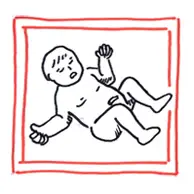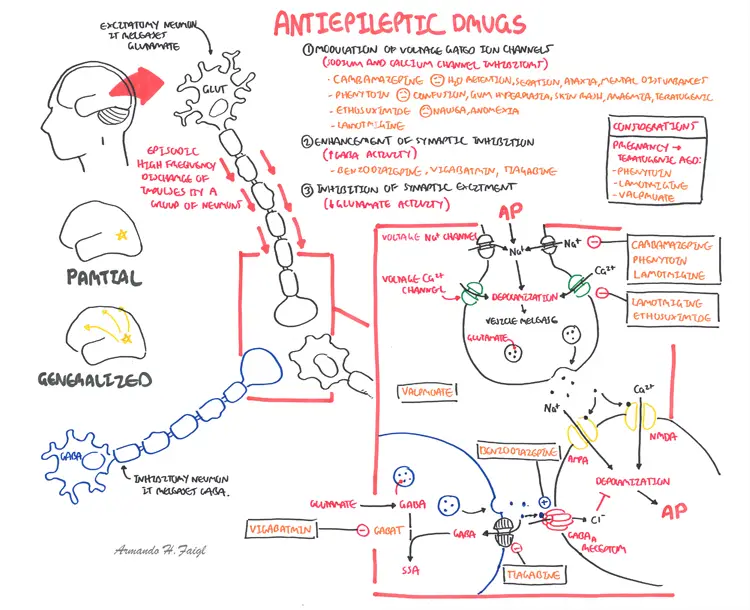
Overview Seizures are a common occurrence in children. 8% will have at least one seizure by 15 years of age. A seizure is the result of an abnormal paroxysmal discharge by cerebral neurons. Many underlying conditions and neurological challenges may provoke seizures, and in over 50% of children seizures are isolated events associated with either a fever (febrile seizures/convulsions) or minor head injury in early childhood. Thus, Seizures can be broadly divided based on:
There are many....many causes of non-febrile seizures, one of which is epilepsy.

Seizures can be classified as focal or generalised
| Definition Seizure: sudden attack of altered behaviour, consciousness, sensation or autonomic function produced by a transient disruption of brain function. The result of this altered brain function is most commonly a tonic (stiffening) or tonic-clonic (stiffening-jerking) seizure. Epilepsy: common set of variable conditions with recurrent seizures. Presents when at least 2 unprovoked seizures occur >24 hours apart. Convulsions: a seizure with motor accompaniments Non Febrile convulsion (seizures): These are seizures occuring without presence of a fever. There are many causes one of which is epilepsy. Febrile Convulsions: a seizure without other known cause occurring between 6 months and 6 years of age with fever |
| Remember Children with a fit and fever may have meningitis |
| Side note Epilepsy and febrile seizures have different classifications |
| SEIZURES TYPES | |
| Partial (focal) | Generalised |
| Simple | Tonic & Clonic |
| Complex | Absence |
| Status Epilepticus | Myoclonic |
| Atonic | |
| Infantile Spasms (West Syndrome) | |
| Status Epilepticus | |
| Definition Tonic: Stiffening Clonic: Jerking Tonic Clonic: Stiffening and jerking Convulsion: a seizure with motor accompaniments Preictal: Before seizure Ictal: During seizure Postictal: after seizure |
| Remember There is no reliable diagnostic test for a seizure. A good first and eye-witness account is essential |
| Remember Prolonged seizure and or repeated disease of antiepileptic's may lead to airway compromise and breathing difficulty. |
Differential Diagnosis of Seizures in general (VITAMIN)
Neonatal epilepsy Differential Diagnosis
| DIFFERENTIATING FEATURES BETWEEN SEIZURE AND SYNCOPE | ||
| Seizures | Syncope | |
| Age | Any | 8-15 years |
| Timing | Whenever | Day |
| Situation | Commonly during activity | Standing |
| Prodrome | Brief (twitching, hallucinations) | Long (dizziness, sweats, nausea) |
| Duration | Variable | Under 5 minutes |
| Tonic-clonic movement | Common | Rare |
| Colour change | Maybe be cyanosis | Pallor |
| Injury | Common | Rare |
| Incontinent of urine | Common | Rare |
| Recovery | Drowsiness, confusion or headache | Quick Recovery |
| Think What happens after the "event" is a big differentiating factor between syncope (quick recovery) and seizure (drowsy, confused, headache, fatigue) |
Identify the cause of seizure if epilepsy has not been diagnosed
Investigations are not necessary for febrile convulsions
Diagnosis of epilepsy
Tests are not performed to determine if a child has epilepsy or not. This is a clinical judgement made by a specialist. However, in general epilepsy is two unprovoked seizures (not related to infection, inflammation or metabolic changes) occurring >24hours apart
Partial or Focal seizures is now known as retained consciousness seziures. Partial seizures start in a focus in the brain. The focus may be the site of previous cerebral damage. Partial seizures may be motor, sensory, automatic or psychic. Partial seizures may occur with or without impairment of consciousness and awareness. Partial seziures are divided into simple partial or complex partial.
| Remember Partial epileptic seizures are classified as either simple partial or complex partial. Whereas, febrile seizure is classified as either simple (generalized seizure) or complex (partial or generalised). GETS CONFUSING! |
Simple
Complex
| Partial with secondary Generalized Begins focal and spreads around brain to become generalized seizure |
Generalized seizures the whole brain is involved characterized by immediate loss of consciousness. It can be defined by a variety of seizures:
Tonic-clonic seizures (Grand Mal) These fits comprise of a:
Flashing lights can be triggers. Seizures can last from less than 1minutes to over 30minutes (status epilepticus)
Absence Seizures (petit mal) Sudden cessation of motor activity or speech with blank stare and blinking. uncommon <5 years of age. No aura and lasts usually <30seconds with no postictal period.
Myoclonic Seizure Repetitive seizures - brief, symmetric muscle contraction and loss of body tone with falling over.
| Remember Single jerks as we fall asleep are normal (physiological myoclonus) |
Atonic Seizure Known as drop attacks. Sudden decrease in muscle tone makes a child lose postural control and drop to the floor.
Infantile Spasms Rare and serious form of seizure occurring usually at age 1-6months. Associated developmental delay is common. The single most common cause is tuberous sclerosis. Treatment: ACTH + Prednisone + anticonvulsants if no response
| Idiopathic infantile spasms "West syndrome": a severe epilepsy syndrome composed of the triad: infantile spasms, hypsarrhythmia on EEG and mental retardation. |
Seizures lasting a few minutes and are self-limiting only need monitoring
| Side note Depending on the type of epilepsy, one to several years free of seizure are generally required before anti convulsants are withdrawn. |

| Watch Pharmacology - Antiepileptic |
Acute Management
Prolonged seizure and or repeated disease of antiepileptic's may lead to airway compromise and breathing difficulty.
Discharge
Prognosis of epilepsy
| Remember after the first afebrile seizure, only 1/3 of children experience further episodes. |
Overview Seizures are common in the first month as a result of birth injury, metabolic and infective causes or developmental abnormalities. Hypoxic ischemia encephalopathy is the most common cause; seizure usually present within 12-24 hours after birth.
| Cause | Presentation | Association |
| Hypoxic ischemia encephalopathy | 12-24 hours | Term, cerebral palsy |
| Intraventricular haemorrhage | 1-7 days | Preterm |
| Metabolic | Variable | Infant of Diabetic mother, inborn errors of metabolism |
| Infection | Variable | TORCH, maternal fever, sepsis, meningitis |
This section will mainly focus on Paediatric Epilepsy (NOT FEBRILE SEIZURES)
| Remember Children and Adults can have seizures because of metabolic disturbances, trauma or being in a febrile state. This does mean they have epilepsy. Epilepsy is a condition characterised by the tendency for recurrent seizures. Presents when at least 2 unprovoked seizures occur >24 hours apart. |
